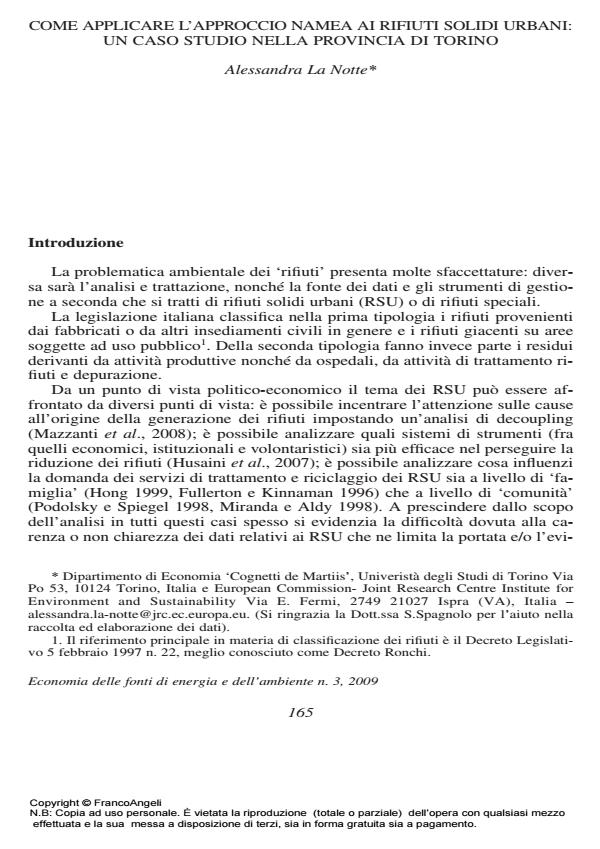Come applicare l'approccio NAMEA ai Rifiuti Solidi Urbani: un caso studio nella provincia di Torino
Journal title ECONOMIA DELLE FONTI DI ENERGIA E DELL’AMBIENTE
Author/s Alessandra La Notte
Publishing Year 2010 Issue 2009/3
Language Italian Pages 22 P. 165-186 File size 1101 KB
DOI 10.3280/EFE2009-003008
DOI is like a bar code for intellectual property: to have more infomation
click here
Below, you can see the article first page
If you want to buy this article in PDF format, you can do it, following the instructions to buy download credits

FrancoAngeli is member of Publishers International Linking Association, Inc (PILA), a not-for-profit association which run the CrossRef service enabling links to and from online scholarly content.
The NAMEA approach for Municipal wastes: a case study in the province of Turin (Italy) - Dealing with solid urban wastes (RSU) requires a peculiar approach: Italian legislation concerning RSU considers different institutions, management regimes and thus also datasets to control and monitor actions and changes. If a local authority aims at tracking origin and destination of RSU making visible the driving causes of waste production and the degree of efficiency of the adopted policies (volume reduction and recycling) it might be useful to apply a NAMEA-type approach which considers economic activities and their environmental impacts. The attempt of this study is to find out whether it is possible to build the environmental side of NAMEA for RSU. The application is undertaken for a group of municipalities within the province of Torino in Piemonte (North-Western part of Italy). The main findings can be summarized into three basic steps to be undertaken. For RSU, in order to apply this kind of matrix it is necessary to identify the ‘strategic’ territorial unit for data collection and processing: consortia among municipalities, as required by the current legislation, seem to be the best unit to build up this kind of accounts. By disaggregating the single consortium we can have data on the single municipality; by aggregating many consortia we can have data about provinces and the region. Secondly, it should be investigated how the data we need could be elicited; in our case study we used the current tariff system (TIA): it allows separating households’ wastes from production sectors’ wastes and it allows estimating wastes produced by economic activities. Finally it is necessary to integrate the NACE classification with the RSU nomenclature: the latter helps in finding the proper reference into the multi-digit NACE codes. Given the high level of details in terms of territory sub-division it is possible to build up the matrix for RSU reporting both origin and destination in terms of treatments and locations. This information helps local planners to check whether the management of RSU is sustainably and efficiently undertaken.
Keywords: Environmental accounting, NAMEA, municipal wastes, waste tax
Jel codes: Q53, Q56, H70
Alessandra La Notte, Come applicare l'approccio NAMEA ai Rifiuti Solidi Urbani: un caso studio nella provincia di Torino in "ECONOMIA DELLE FONTI DI ENERGIA E DELL’AMBIENTE" 3/2009, pp 165-186, DOI: 10.3280/EFE2009-003008